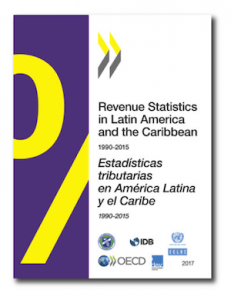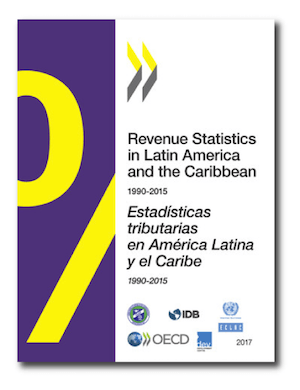 Tax revenues in Latin America and the Caribbean (LAC) countries continued to increase in 2015, according to new data from the annual Revenue Statistics in Latin America and the Caribbean publication. The average tax-to-GDP ratio for LAC countries reached 22.8% of GDP in 2015, up from 22.2% in 2014.
Tax revenues in Latin America and the Caribbean (LAC) countries continued to increase in 2015, according to new data from the annual Revenue Statistics in Latin America and the Caribbean publication. The average tax-to-GDP ratio for LAC countries reached 22.8% of GDP in 2015, up from 22.2% in 2014.
The report, produced jointly by the Inter-American Centre of Tax Administrations (CIAT), the Economic Commission for Latin America and the Caribbean (ECLAC), the Inter-American Development Bank (IDB), the Organisation for Economic Co-operation and Development (OECD) Centre for Tax Policy and Administration and the OECD Development Centre, covers 24 LAC countries, including Cuba and Belize for the first time. It was launched today during the 29th Regional Seminar on Fiscal Policy, held at ECLAC headquarters in Santiago, Chile.
The average tax-to-GDP ratio across LAC countries is currently 11.4 percentage points lower than the OECD average of 34.3%.The difference between the OECD and LAC countries is mainly explained by lower tax collection on personal income taxes and social security contributions in the LAC region; however, the difference between OECD and LAC tax-to-GDP ratios in 2015 is the smallest on record.
Surging revenues from the value-added tax (VAT) and excise taxes offset a decline of 0.2 percentage points in corporate income tax revenues and explain the overall increase in the LAC average tax-to-GDP ratio in 2015. This is the first decrease in corporate income tax revenues across LAC countries since 2011. In contrast, personal income tax revenue has reached its highest level, during the period covered in this report, at 2.1% of GDP.
Revenue Statistics in Latin America and the Caribbean shows that there is a wide variation of tax-to-GDP ratios across countries. Tax-to-GDP ratios in LAC counties range from 12.4% in Guatemala and 13.7% in the Dominican Republic to 32.0% in Brazil, 32.1% in Argentina and 38.6% in Cuba, which is the only country that had a tax-to-GDP ratio above the OECD average.
Amid these differences, a common feature in the region continues to be the reliance on indirect taxation as the main revenue source. On average, indirect taxation accounted for a share of 49% of total tax revenue in LAC countries in 2014, compared with an average of 33% in OECD economies.
The share of corporate income tax revenues in the LAC region remained high compared to OECD levels (16.8% of total tax revenues compared to 8.7% respectively on average) whereas the personal income tax revenue share was much lower than in OECD countries (8.8% and 24% respectively).
A special feature in this year’s report analyses the impact of declining international commodity prices on fiscal revenues. The substantial reduction of oil prices since 2014 resulted in a significant fall. As a result, oil-related public revenues went from 6.8% of GDP on average in 2014 to 4.4% in 2015 for the 10 LAC countries included in the analysis. Similarly the decline in mineral and metal prices reduced mining-related public revenues from 0.5% of GDP in 2014 to 0.4% in 2015. Further falls are predicted for revenues deriving from both commodities in 2016.
A second special feature of the report analyses the financing structure of sub-national governments in nine LAC countries. Sub-national tax revenues in these countries derive principally from recurrent taxes on immovable property, taxes on consumption and taxes on business and motor vehicle licences. Sub-national governments in Argentina, Brazil and Mexico were found to have a high level of tax autonomy defined as the degree on which sub-national governments can enforce new local taxes, define tax bases and grant tax exemptions to individuals and companies. In contrast, in Chile 58% of sub-national tax revenue is subject to a tax-sharing agreement with the central government.
Key findings
Tax to GDP ratios
• On average, tax revenues in Latin America and the Caribbean increased from 22.2 % in 2014 to 22.8% of GDP in 2015, a 0.6 percentage point increase. In comparison, tax revenues averaged 20.8% of GDP during the last decade.
• Tax revenue growth was driven by taxes on goods and services, which grew by 0.5 percentage points. Personal and property taxes also increased by 0.1 percentage point. Additionally, social security contributions rose by 0.1 percentage points. These increases offset a decline of 0.2 percentage points in corporate income tax revenues.
Tax Structures
• Taxes on income and profits as a share of total tax revenues increased between 2003 and 2014, spurred by the increase in prices of commodities in LAC countries. A small decline in the share of these taxes was observed in 2015, from 28.1% to 27.2% of total tax revenue.
• The share of taxes on goods and services decreased from 55% of total tax revenues in 1990 to 49% in 2014. By contrast, in OECD countries, it remained stable at around 33% during the same period.
Press Contacts:
• CIAT Inter-American Centre of Tax Administrations. Neila Jaén (Publication and Communication Coordinator), njaen@ciat.org, T: + (507) 307-2428
• ECLAC, Public Information Unit, prensa@cepal.org, + (56 2) 22102040
• IDB Office of External Relations, Mildred Rivera, Communications Specialist, mildredr@iadb.org, T: +1 202 623-2319
• OECD Centre for Tax Policy and Administration, Michelle Harding , (Michelle.Harding@oecd.org, +33 1 45 24 93 68) and Emmanuelle Modica (Emmanuelle.Modica@oecd.org, +33 1 45 24 96 66) In Paris
• OECD Development Centre, Angel Melguizo, ( Angel.Melguizo@oecd.org, cellphone: +33 6 01 05 53 34) in Santiago and Bochra Kriout (Bochra.Kriout@oecd.org, Tel.: +33 1 45 24 82 96) in Paris.

